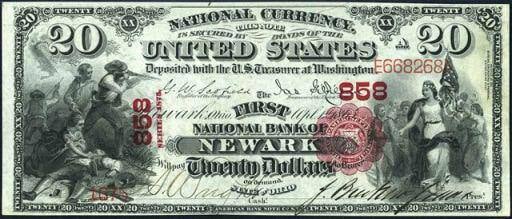


From the early days of the United States to modern initiatives for greater representation, images on currency offer a window into a nation’s values and history. Despite the progress made in recent years, women have been notably underrepresented on U.S. paper money. This article explores the historical milestones of women featured on U.S. currency, draws comparisons with international practices, and explains how—and why—the decisions about who appears on U.S. money are made.
Women’s images on American coins and banknotes have appeared sparingly but meaningfully throughout history:

Martha Washington:
In the late 19th century (1886-1889), Martha Washington became the only woman to be featured solo on U.S. paper currency with her portrait on the $1 silver certificate. Her appearance was a product of its time—a period when women's historical contributions were beginning to be recognized, albeit very sparingly (National Museum of American History). Martha was also included on the back of the $1 bill in a portrait next to her husband, George Washington, in 1896.

Susan B. Anthony and Sacagawea:
In 1979, the Susan B. Anthony dollar coin marked the first time a woman was depicted on circulating coinage, replacing a longstanding tradition of exclusively featuring male figures. A couple decades later, the Sacagawea golden dollar was introduced in 2000. Sacagawea’s depiction—capturing the spirit of Native American leadership and the historic Lewis and Clark expedition—has since become a familiar and celebrated image in U.S. wallets (US Mint – American Women Quarters Program).

Helen Keller:
Helen Keller’s likeness appeared on the Alabama state quarter in 2003, bridging recognition of disabled Americans with the celebratory spirit of state honor. Although primarily featured on commemorative coins, these instances underscore an evolving acknowledgment of diverse contributions in U.S. history.

American Women Quarters Program (2022–2025):
In recent years, the U.S. Mint has actively sought to expand representation by launching initiatives like the American Women Quarters Program. This program features notable American women—including icons such as Maya Angelou, Sally Ride, and Celia Cruz—on the reverse of quarters, ensuring that everyday currency carries a broader array of American stories (ONE.org).

Upcoming Reforms:
Additional plans have been announced to feature figures like Harriet Tubman on redesigned currency. Despite earlier announcements and public debates, the process has continued at a deliberate pace, reflecting the complexities involved in such a deep-rooted tradition (Wired).
While the United States has been slow to revamp its long-standing traditions, other countries have embraced female figures on their money for decades:
Australia:
Modern Australian banknotes feature women among its celebrated designs, acknowledging figures that range from historic royalty to trailblazing social leaders.

United Kingdom:
The UK has featured Queen Elizabeth II on various coins and recently on banknotes, while also commemorating historical icons such as Jane Austen on the £10 note (Visual Capitalist).


Mexico and Sweden:
Mexico’s currency has honored artist Frida Kahlo, and Sweden has celebrated cultural icons like author Astrid Lindgren on their money. These choices reflect a national acknowledgment that women have played pivotal roles in shaping cultural and public identities.


The international landscape reveals a broader acceptance—and even a proactive integration—of women as national symbols on both coins and banknotes.
The decision about who appears on U.S. currency is not made arbitrarily. Instead, it is guided by a well-established process that blends administrative expertise, legal mandates, and, increasingly, public input:
Governmental Authority:
The U.S. Department of the Treasury ultimately holds the authority to decide the images on paper money. The Secretary of the Treasury is the final decision-maker, in collaboration with agencies such as the Bureau of Engraving and Printing (BEP), which handles the design and security features of each bill (moneydigest.com).
Legal Limitations and Historical Precedent:
By law, only deceased individuals may be depicted on U.S. paper currency—an edict that reinforces a reliance on historical, well-established figures. This regulation, coupled with tradition (a legacy of predominantly featuring presidents and founding fathers), has meant that very few women have met the criteria over the decades.
Public Opinion and Social Media Movements:
In recent years, campaigns such as Women on 20s and social media hashtags like #TheNew10 have sought to influence this process by highlighting the contributions of leading women and advocating for their inclusion on more widely used currency denominations. Although these movements do not determine the final outcome, they have helped nudge policy discussions toward greater inclusivity (wired.com).
Currency redesign is not solely about changing portraits—it is a rigorous, technical process that incorporates new anti-counterfeiting measures and tactile features (to aid the visually impaired). Every time a currency series is updated, the Treasury not only rethinks the artistic elements but also ensures that the bill can withstand the challenges of modern security threats. Hence, changes to the figures on paper money occur infrequently due to both financial cost and the rigorous testing required to implement new designs.
Tradition and Inertia: Once a tradition is established—like featuring a select group of male leaders on U.S. currency—it can be difficult to change. The engravings and designs selected in the early 20th century have had decades to become icons, even if they no longer reflect the full diversity of American achievements. Changing these images requires overcoming not only technical and budgetary challenges but also deep-seated cultural expectations.
Despite these challenges, recent years have seen a growing movement among historians, activists, and the public to address this gender gap. Public campaigns and academic discussions highlight that updating currency to reflect both historic and contemporary contributions of women could have a profound inspirational impact—especially on young girls and future leaders.
At the heart of the process lies a complex blend of legal mandates, bureaucratic traditions, and shifting public attitudes. As movements for greater inclusion gain momentum, and as other nations continue to set examples with their diverse representations, America faces a pivotal challenge: to update its symbols in a way that honors the contributions of all its people.
>Through persistent advocacy and evolving cultural values, the hope is that future currency—and all national symbols—will better reflect the true diversity and richness of American history.


.png)
